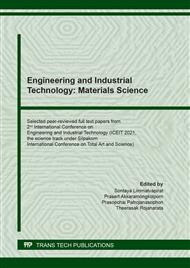[1]
T. Eng-Chong, L. Yean-Kee, C. Chin-Fei, H. Choon-Han, W. Sher-Ming, C.T. Li-Ping, F. Gen-Teck, N. Khalid, N. Abd Rahman, S.A. Karsani, S. Othman, R. Othman, R. Yusof, Boesenbergia rotunda: from ethnomedicine to drug discovery, Evid. Based Complement. Alternat. Med. (2012) 473637.
DOI: 10.1155/2012/473637
Google Scholar
[2]
S. Charoensin, C. Punvittayagul, W. Pompimon, U. Meevatee, R. Wongpoomchai, Toxicological and clastogenic evaluation of pinocembrin and pinostrobin isolated from Boesenbergia pandurata in wistar rats, Thai J. Toxicol. 25 (2010) 29-40.
DOI: 10.1016/j.toxlet.2010.03.568
Google Scholar
[3]
P. Saraithong, S. Saenphet, K. Saenphet, Safety evaluation of ethanol extracts from Bosenbergia rotunda (L.) Mansf. in male rats, Trends Res. Sci. Technol. 2 (2010) 19-22.
Google Scholar
[4]
Y. Teethaisong, T. Pimchan, R. Srisawat, G. Hobbs, G. Eumkeb, Boesenbergia rotunda (L.) Mansf. extract potentiates the antibacterial activity of some β-lactams against β-lactam-resistant staphylococci, J. Glob. Antimicrob. Resist. 12 (2018) 207-213.
DOI: 10.1016/j.jgar.2017.10.019
Google Scholar
[5]
R. Jitvaropas, S. Saenthaweesuk, N. Somparn, T. Amornnat, S. Sireeratawong, W. Phoolcharoen, Antioxidant, antimicrobial and wound healing activities of Boesenbergia rotunda, Nat. Prod. Commun. 7 (2012) 909-12.
DOI: 10.1177/1934578x1200700727
Google Scholar
[6]
M. Dyson, S. Young, C.L. Pendle, D.F. Webster, S.M. Lang, Comparison of the effects of moist and dry conditions on dermal repair, J. Invest. Dermatol. 91(5) (1988) 434-439.
DOI: 10.1111/1523-1747.ep12476467
Google Scholar
[7]
J. Koehler, F.P. Brandl, A.M. Goepferich, Hydrogel wound dressings for bioactive treatment of acute and chronic wounds, Eur. Polym. J. 100 (2018) 1-11.
DOI: 10.1016/j.eurpolymj.2017.12.046
Google Scholar
[8]
E.A. Kamoun, X. Chen, M.S. Mohy Eldin, E.-R.S. Kenawy, Crosslinked poly(vinyl alcohol) hydrogels for wound dressing applications: a review of remarkably blended polymers, Arab. J. Chem. 8(1) (2015) 1-14.
DOI: 10.1016/j.arabjc.2014.07.005
Google Scholar
[9]
P. Eakwaropas, Y. Myat, T. Ngawhirunpat, T. Rojanarata, P. Patrojanasophon, P. Akkaramongkolporn, P. Opanasopit, Optimization of Boesenbergia rotunda extract-loaded polyvinyl alcohol hydrogel wound dressing by Box-Behnken design, Key Eng. Mater. 819 (2019) 38-44.
DOI: 10.4028/www.scientific.net/kem.819.38
Google Scholar
[10]
Y. Tang, X. Lan, C. Liang, Z. Zhong, R. Xie, Y. Zhou, X. Miao, H. Wang, W. Wang, Honey loaded alginate/PVA nanofibrous membrane as potential bioactive wound dressing, Carbohydr. Polym. 219 (2019) 113-120.
DOI: 10.1016/j.carbpol.2019.05.004
Google Scholar
[11]
A. Ullah, S. Ullah, M.Q. Khan, M. Hashmi, P.D. Nam, Y. Kato, Y. Tamada, I.S. Kim, Manuka honey incorporated cellulose acetate nanofibrous mats: fabrication and in vitro evaluation as a potential wound dressing, Int. J. Biol. Macromol. 155 (2020) 479-489.
DOI: 10.1016/j.ijbiomac.2020.03.237
Google Scholar
[12]
P. Picone, M.A. Sabatino, A. Ajovalasit, D. Giacomazza, C. Dispenza, M. Di Carlo, Biocompatibility, hemocompatibility and antimicrobial properties of xyloglucan-based hydrogel film for wound healing application, Int. J. Biol. Macromol. 121 (2019) 784-795.
DOI: 10.1016/j.ijbiomac.2018.10.078
Google Scholar
[13]
T. Brás, D. Rosa, A.C. Gonçalves, A.C. Gomes, V.D. Alves, J.G. Crespo, M.F. Duarte, L.A. Neves, Development of bioactive films based on chitosan and Cynara cardunculus leaves extracts for wound dressings, Int. J. Biol. Macromol. 163 (2020) 1707-1718.
DOI: 10.1016/j.ijbiomac.2020.09.109
Google Scholar
[14]
Z. Xu, H. Shuyan, Z. Gu, J. Wu, Advances and impact of antioxidant hydrogel in chronic wound healing, Adv. Healthc. Mater. 9 (2020) 1901502.
DOI: 10.1002/adhm.201901502
Google Scholar
[15]
W. Zhang, L. Chen, Y. Xiong, A.C. Panayi, A. Abududilibaier, Y. Hu, C. Yu, W. Zhou, Y. Sun, M. Liu, H. Xue, L. Hu, C. Yan, X. Xie, Z. Lin, F. Cao, B. Mi, G. Liu, Antioxidant therapy and antioxidant-related bionanomaterials in diabetic wound healing, Front. Bioeng. Biotechnol. 9 (2021) 707479.
DOI: 10.3389/fbioe.2021.707479
Google Scholar


